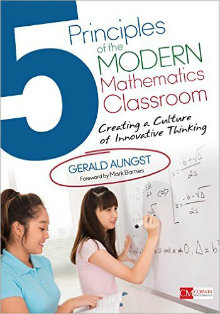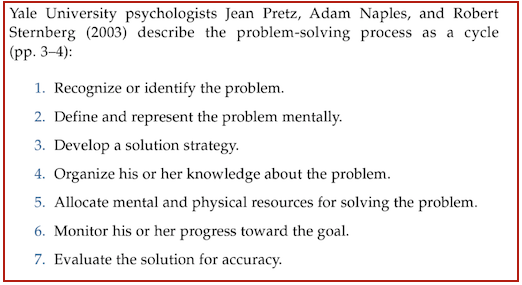Nurture Innovative Thinking in Math Class
5 Principles of the Modern Mathematics Classroom: Creating a Culture of Innovative Thinking
By Gerald Aungst
(Corwin, 2016 – Learn more)

Sitting at a district-led professional development day with a guest speaker teaching, I found myself with the 5 Principles of the Modern Mathematics Classroom under the table reading and laughing literally out loud at certain sections.
The book was far more engaging than the speaker in front of me, and my tablemates quickly became engrossed in what I was reading, wanting the book to be passed around and calling dibs on who got to read it next.

Aungst discusses the “perverse pride in mathematical ignorance” that appears in our culture in the United States and compares it to Eastern and European cultures where it is absent. A statement that resonated with me: while many say they are bad at math, yet in the US they wouldn’t state they are bad at reading.
In addition, he highlights on American teaching culture with its dislike of students being up out of their seats and moving around the classroom, and the neverending teacher complaint of not having enough time due to state testing and content requirements.
Building a classroom culture of success
After using humor to entice me in (with all the feelings I have about math education), Aungst goes on to talk about what is required to help students be successful in mathematics.
He discusses how to incorporate mathematical processes and approach the dreaded problem solving. He includes the likes of Jo Boaler and Robert Kaplinsky, and notes that the goal of problem solving should be to entice students like a good mystery TV show or a mystery novel. Problem solving, he says, is a cycle, not a recipe, and within the cycle there are seven steps that are critical for students to be successful.
Unfortunately, the traditional American math classroom focuses on steps 5 & 6, Aungst says, doing the most important problem-solving work (1-4) FOR the student before the problem is even introduced. Not surprisingly, Aungst focuses much of the book’s narrative on the critical early steps.
Within each chapter on the five principles he gives example problems and explains how to go about incorporating the suggested strategies, which are sorted by grade levels and cross listed with the mathematical practice it addresses. In addition, he includes a variety of resources such as Math Pickle, Stella’s Stunners, and Bedtime Math, to name a few I wasn’t as familiar with. Of course the standard web pages were there too, including Dan Meyer’s – 3 Act Math, the National Library of Virtual Manipulatives, Alice, and Geogebra.
One of the best new math books available
I strongly recommend 5 Principles of the Modern Mathematics Classroom for math teachers of any grade including post K-12 instruction. The book provides a strong basis in the history of mathematics and how to address problem solving in a powerful, meaningful, and realistic way. This will be a book that I go back to frequently as it is one of the better math education books to be published lately.
____________
Maia Fastabend is a 6th year teacher from Southern Oregon who when not teaching can be found whitewater kayaking or trail running. She has experience teaching 6th-8th grade general math and advanced math, and recently has found her niche teaching remedial/support. Musings about her teaching and current topics can be found at http://teachrunlife.blogspot.com/.




































